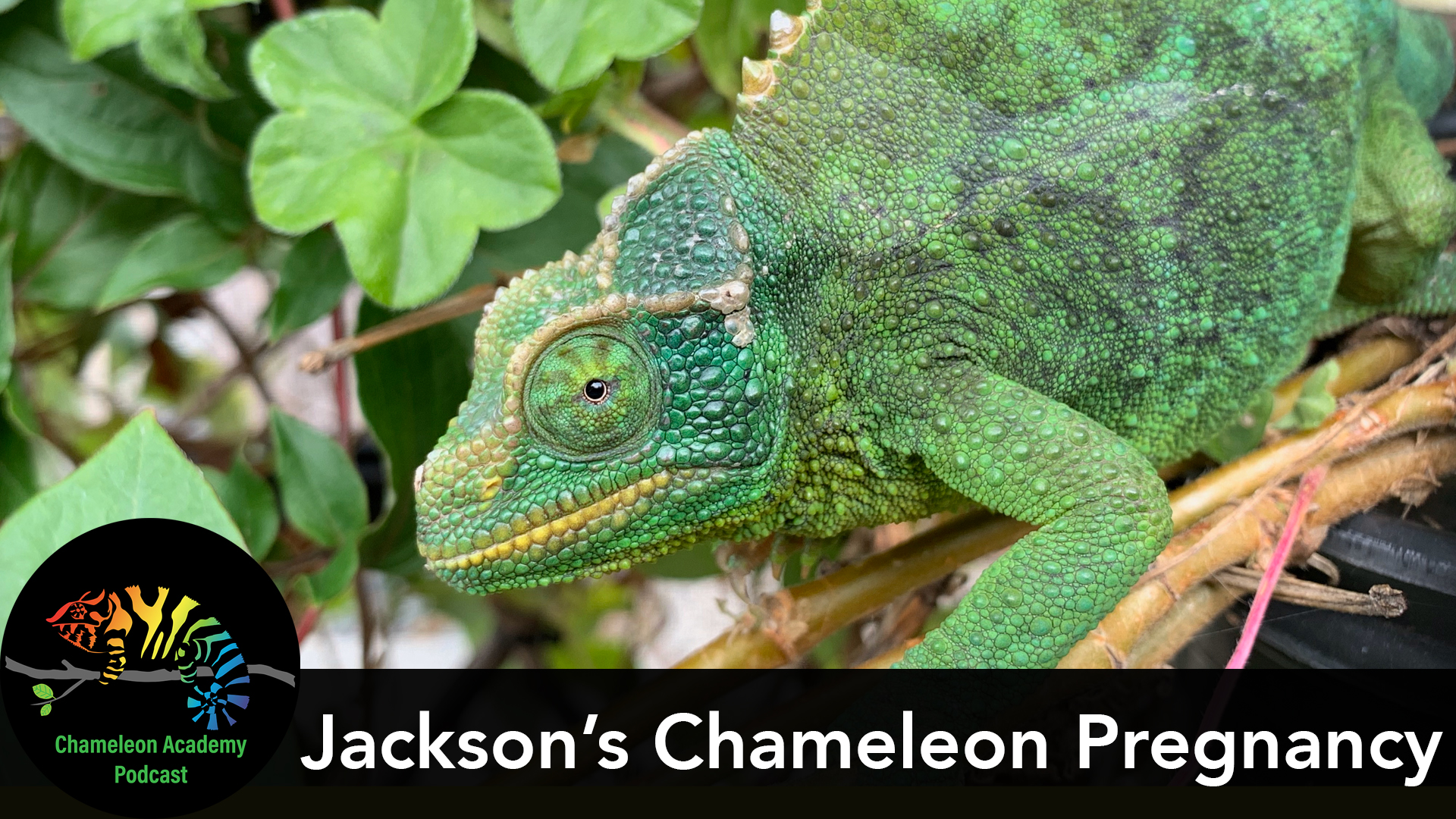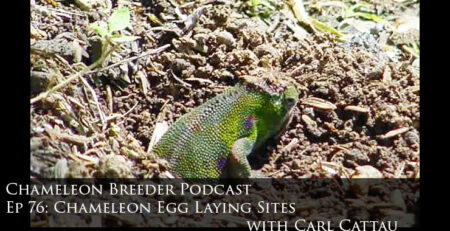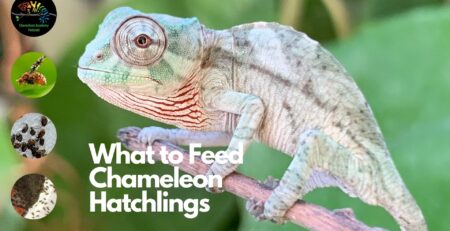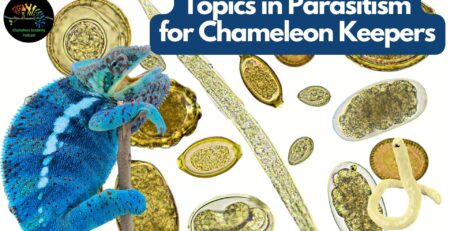The Jackson’s Chameleon Pregnancy
Today I talk about the pregnancy period of the Jackson’s Chameleon to help you understand the steps before the babies are born. The live bearing nature of Jackson’s Chameleons can be a mystery, but there are things that we can notice. In this episode I talk about the different stages of pregnancy in the Jackson’s Chameleon.
Jackson's Chameleon Pregnancy Transcript (more or less)
Today I want to talk about one of the mysterious happenings in a chameleon keeper’s life and that is live birth from a chameleon. It is mysterious because it often happens when we aren’t expecting it. The first cause is many people aren’t aware that live birth exists in chameleons. The second is that Jackson’s chameleons and other live bearing species are able to store sperm. This means that you are getting fertilization after the mating and the mating could have been long before you obtained the female. Surprise surprise!
There has been much attention on what to do with the babies when they are born because that is the big dramatic moment, but today I am going to focus on the 6-9 months before that and we are going to talk about the time that the female is pregnant. Now, first, terminology. In the community we often use the words pregnant and gravid interchangeably. As with all words, meanings evolve. Sometimes pregnant is used for livebirth and gravid for egg laying females, but this is not a official designation. In fact, live bearing females are doing nothing different except laying the eggs after the baby is ready to hatch. So, you can use whatever word you are comfortable with. As is always the case, when people get comfortable with a specific term and definition in their head they tend to become rigid in how they want to hear it from others so expect a certain level of confusion in the community. This conflict is can be filed in the folder of things we should not worry about but, of course, will fight to the death about because that is what humans are. So, in this episode, I choose to use the word pregnant when talking about live birth and gravid when referring to egg laying or live birth. But please understand, these subtle distinctions are my choice and not scientific convention.
In chameleons, gestation is a term that refers to the length of time between fertilization and egg laying. Remember that a live birth chameleon is just laying her eggs later in the process. They simply don’t calcify and are incubated within the mother’s body. So, is gestation and incubation the same for live bearing chameleons? We are having so much fun with word play and I haven’t even gotten to husbandry. So I’ll wrap this up by saying that I will refer to the time between fertilization and the birth of live babies as gestation.
So, let’s start with fertilization. It is common for chameleons to store sperm from one mating to be used later. It is unknown how long the sperm is good for, but it is long enough that a female could use the store of sperm a couple years later. And this comes from simple observation of how long my Jackson’s Chameleons have gone without mating and still producing babies. I do not know what an average is or what the maximum length of time is. Female live bearers have many secrets that they still keep. What we do know is that the number of eggs fertilized in clutches after the mating typically goes down. So this probably means that the older the sperm gets the less viable they are. This has significance when you are actively breeding. There may be a short window where the female is receptive after giving birth and if you miss that she will just take matters into her own hands and fertilize herself with the results of a previous mating. So your female will go through the stresses of a reproduction cycle with less production of babies. If you are a panther chameleon breeder making a living on chameleons or just a rare species chameleon breeder you do not want your female wasting energy caring for a clutch that is half viable. On the other hand, my breeding strategy with Jackson’s Chameleons is to mate the females early in life when they are first receptive. This often around one year old, but is more dependent on size then age and depends on husbandry conditions. What this does is give me small broods of babies to care for. You see, as they get older and bigger, the female Jackson’s Chameleon will produce more babies. A first time brood could be between 8 and 12 neonates. A fully mature female once gave me 52 neonates. I actually give them one mating when they are first receptive and I let the rest of their life’s production rest on that event. I am looking for the decreased fertility to limit the brood sizes as the females gets larger. Jackson’s Chameleons are like any other chameleon in that the ideal husbandry for babies is to keep them individually. So larger broods are not always the blessing you would think! I specifically desire smaller broods because the fewer they are the easier it is to give the ideal care.
The first external sign that a mating has “took” or the female has started the gestation process is that she starts to get rotund around the middle. Jackson’s chameleons, particularly, have a rotund shape normally so it does take a trained eye to notice the difference in the early days. What we look for is the weight gathering closer to the tail end rather around the middle of the body. As the gestation progresses this becomes more and more obvious.
As the body grows outward more and more I often get the question as to how many babies she will have. This is a tricky question to answer because the same size could hold many smaller babies or fewer larger babies. So any estimate is merely an estimate. Do you see how hard it is to know everything about these chameleons even with decades of experience? Those decades of experience only shows us how little we know. The best way to be an expert is to breed Jackson’s once and then decide that is how every gestation should go! And stop there! By doing it again you will only see how different it can be! You know the old saying that a man with one watch always knows what time it is, but a man with two watches never knows what time it is? Yeah, it is the same with chameleons! This is why keepers with one chameleon can be so darn confident in what they know!
This is a critical time as far as nutrition. How you feed the mother during this stage dictates the health of the babies when they are born. So make sure all the nutrition bullet points are in place. These include the feeding of your feeder insects with a variety of fruits, vegetables, grains, and whatever the feeder insect naturally eats, if possible. What does a cricket naturally eat? What does a superworm naturally eat? How about a dubia roach? Yep, we chameleon keepers end up becoming invert husbandry nerds too! You can try pre-made diets. They represent someone’s research into what insects need. The problem is that there is so much we don’t know so there is a lot of guessing and throwing everything in there to try and hit the right combo. I have been trying Repashy Bug Burger, but how can these things be good for crickets, superworms, and dubia? How can one mix give such diverse feeder insects the nutrition they need? Well, this is all part of the research and exploration we are doing in the community. At this point, be generous in feeding your feeders. Ad I do it for 48 hours before I feed them off to make sure they had the chance to eat their fill.
And then there is supplementation. Dusting with calcium makes sure your chameleon is getting enough calcium. And your UVB needs to be on point. Jackson’s seem to be sensitive to the multi-vitamin powders we have in the community so we generally use low fat soluble dose powders like Repashy Calcium Plus LoD once or twice a month. If you have sufficient UVB then once a month powder dusting should be fine. That is providing the vitamin A.
Nutrition is a huge topic and one worth checking out past episodes on nutrition. But it could easily take over this episode because there is so much to talk about! So I will leave the topic of chameleon nutrition to your free time.
Does it seem like I am going over a mini run down of chameleon husbandry? That is because I am! You don’t take care of a gravid female any different than you would a non-gravid female. The only difference is that when they are gravid there is much less tolerance for cutting corners. And the consequences of doing so will stare you in the face when the babies are born. And since you are never sure when the female decides to start the next generation, you are just trapped into giving excellent chameleon husbandry all the time!
Different species have different gestation lengths. A Jackson’s Chameleon is between 6 and 9 months on average. But she can start a pregnancy when she decides conditions are right and she can delay birth if conditions take a down turn when time gets near. So, yeah, its a lot of fun making caresheets for this species.
As the months continue on you will see more and more of the unmistakable sign of the belly growing out to the side. You may see her actively basking her belly to provide the correct incubation. And you will notice somewhere along the way that her appetite is pretty healthy. Jackson’s females, especially the xantholophus subspecies, love their food and will even ignore the human hand to get at it. I can hold a female xantholophus on my hand and she will forget how annoyed she is with me at the sight of food on some flower. So, you will get used to a healthy appetite. And, go ahead and feed her all she wants. Once the body has decided how many babies to have the die is cast and that is your number. Feed her all the nutritious feeders she wants. It is all going to the babies.
Somewhere about now you need to start thinking about fruit fly cultures. It takes time to establish these and the babies will eat a lot. One of the biggest stress points for a new keeper of a clutch of baby chameleons is feeding them. And just buying a cup of fruit flies may get you a cup that will be blooming, as we call it, in a week or so. Which does no good now! The best thing is to start the fruit fly cultures now! We keepers of live bearing species never know when we are required to provide fruit flies so we have to be ready at all times. As for what do you do with mature colonies when you don’t have your babies yet? Well, that is why I advocate for chameleon people to get dart frogs in their life!
All well and good. But, seemingly suddenly, she stops eating. You panic because you know she is getting large and must need the calories! This is actually a warning sign that birth is likely within days. Now, I have to preface this with the following caveats.
- Not every chameleon listens to this podcast and know what they should be doing. Each chameleon is an individual and will do what they do. Sometimes it goes against what we expect from chameleon behavior. That is just part of what we are doing here. And we need to roll with the punches. Everything that I am laying out here is what we observe over a large number of Jackson’s Chameleons. This behavior list I am describing is an average across multiple species. But that does not guarantee that yours will adhere tot his 100%
- There are other, non-healthy reasons why a female would stop eating. So make sure her eyes and other body signals are active and
But assuming everything checks out, a female suddenly stopping her voracious eating is a sign that birth could happen in the next two or three days. During this time you have your final checklist. Lots of branches for restless climbing all over while she births the babies. A Clear bottom of the cage. Nothing that gathers water. The babies will be deposited all over and will climb all over. They can easily drown so be a stickler for water in the cage. Remove any puddle, permanent or temporary. Babies come out in a sac which they need to break out of. Don’t have an open cup or bottle of water or fountain, or any open water available.
Birthing almost always takes place first thing in the morning. The female will get restless and then start dropping babies. And, by dropping babies, I mean, well, dropping babies. It almost looks like she is dropping a poop, but then you see the poop struggling. This is the baby being woken up by the birthing process and breaking out of the membrane sack it is in. The mother does her best to drop them in different places. I am guessing this is to give the babies the best chance possible by helping them disperse. Babis seem to have the same programming so if they are kept in a certain area for whatever reason (like a cage), they will look for the same things. The first thing they look for is to disperse. So, in the first hours you will see them scrambling all over the cage walls looking to get away. They aren’t trying to get away from the mother. They are trying to disperse and make it harder for predators to get more than one baby. Once they have crawled around a bit, then their priority turns to being hidden and safe and at this point they start settling inside the foliage of the cage. Do you remember those pictures of a huge clump of babies sleeping in a ball? This isn’t a social behavior. This is all of them looking for the same things to be safe and meeting the rest of their brothers and sisters that had the same programming. This happens a lot in a cage because there isn’t far they can go and so when it is time to turn in for the night, all the babies are looking for the same thing and they find it on their own. They are not worried about the mother eating them and you don’t have to worry either. You absolutely should remove them from the mother’s cage within a day or so because we don’t know how long until the mother gets hungry and resists the maternal chemical wash in her brain. I, actually, have never seen a case where the mother has eaten babies left in the cage with her. I just can’t say it is 100% safe because I do not understand the dynamics behind what is going on to suppress the mother from seeing the babies as food. Though, of course, it makes perfect sense from an evolutionary standpoint. The mothers that did see the babies as food did not pass on those genes so it was a self-limiting behavior!
Unfertilized ova
Now, during the birthing you may notice large yellowish blobs dispersed with the babies. These are unfertilized ova meaning they are eggs that were not fertilized with sperm, but was activated to go through the process anyways. I do not know how the body decides to do this or what criteria to use to determine the number. Perhaps it is actually dependent on the viability of the sperm and the female’s body did her part. Though I have seen some first broods having unfertilized ova so it is a complicated situation. All you need to know is that it is completely normal and nothing to worry about.
During birthing you may also notice babies not strong enough to make it out of their sac and the question always comes up as to how much you should assist them. And this is something for you to decide. How long they would survive if you help them is completely dependent on what the reason is they are having issues. For me, I choose not to help the process as not all babies are 100%. Some didn’t get enough nutrients or just plain aren’t strong enough. I have no way of knowing if that is something I could fix with proper care, but I choose to allow the birthing process to be a test of strength. Because this baby may grow up to be a breeder and I want the strongest genetics going forward. But this is a personal choice and I do not judge anyone who chooses differently. But one thing I do is I study each of the babies that are still born or weak and I try and find patterns. I assume this is something wrong in my nutrition of husbandry of the mother. While it is true that things happen that are out of our control and sometimes there are internal complications, I, by default, assume it is something in husbandry because that is the only thing I can change. I like things that are my fault because that means I can change the outcome next time. So you’ll find I actually hope it was something I did wrong. Anyways, You’ll get live babies running around, bright yellow unfertilized ova on the ground, and weak or stillborn babies still in their sacks. You could get any of these, all of these, or just a bunch of babies running around!
The entire process will last a couple hours. She will drop one, move over, drop another, move over, and drop another. During this time she will take rest periods. You are welcome to remove babies during these rest periods, though be as non-intrusive as possible. Remove the babies at your leisure and when it is not disruptive to the birthing process. As I said, I have yet to see a mother eat a baby so I feel comfortable saying you can not worry about it. Of course, someone somewhere will have a story that contradicts me. But, amongst the circle of breeders I hang out with, their experience matches mine that we have not yet seen the babies being eaten.
The babies should be removed and, ideally, placed in individual cages. I realize that this is only starting to take hold as a breeder practice, but it is the best way and so I will continue to talk about it! Give the babies food ad libitum. Let them gorge themselves and grow as fast as they can.
Now, let’s circle back to the mother. She has been through a whole lot! Once the babies are removed and she is done with her ordeal then provide her with food and water and let her rest. You will know when she is done when she isn’t restless anymore and her rest period takes longer than usual. She has done quite a bit! Now you need to pamper her! You can feed her as much as she will eat for that first week after. Let her replenish her strength. So much of her inside body cavity was taken up by these babies so her stomach may react with a vengeance once it figures out it has all that space now. But you’ll get a feel for the situation as to when you should taper off the food. Jackson’s Chameleons are not as prone to overfeeding as Veiled Chameleons, but, even though the incidences are much fewer, it is still part of what we need to manage to be able to keep them in prime condition. Jackson’s are prone to gout, edema, and being over-weight so we need to e on top of our game here and not just give them what we think they want. Yes, I know they are irresistibly cute and you want to give them everything they ask for. But resist for their sake!
Conclusion
I have had females immediately go into another pregnancy and have babies six months later. The thing is that once you get the ball rolling with one mating, her body will then go on autopilot. In fact, you won’t be able to stop it. So, it becomes a normal part of keeping a female Jackson’s chameleons if she has ever had time with a male. That is just an aspect of keeping Jackson’s Chameleons that we need to understand and accept.
The live birth aspect of Jackson’s Chameleons is amazing and, if you are ready for it, one of the coolest things. If you are not ready for it it can be one of the most panic inducing things! And, Jackson’s Chameleons are not the only live bearing chameleon species. Presently available in the trade, Trioceros ellioti and Trioceros hoehneli are also live bearing. Should Tanzania ever export again you will see many other live bearing species.
Sign off
Through this podcast I hope you have been able to learn some of the signs of a gravid live bearing chameleon. And you can now be more confident as to what is going on inside the cage. Sometimes these behaviors can be confusing. But that is just part of what we take on when we step foot into this intricate world.
Thank you for joining me here












